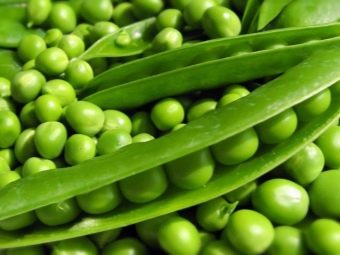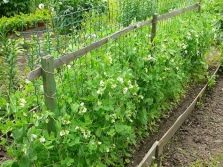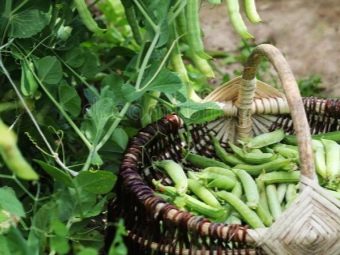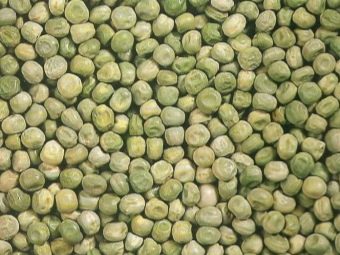How to grow peas?
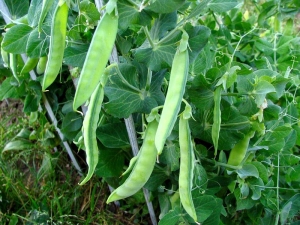
Peas occupy an important place among the crops growing in gardens and in gardens. But novice farmers to cope with its cultivation is not too easy.It is very important to understand all the intricacies before starting such work.
Variety selection
Peas are grown on large plantations and small gardens. It is planted in all parts of the country, using carefully selected seeds. But all these moments, as well as the wide range of application of the plant, require careful evaluation of the characteristics of the variety.
Shelling type gives smooth seeds in the form of spheres with a significant occurrence of parchment. Ripe shelling peas due to the saturation of starch can only be eaten stewed or boiled. Unripe fruits are suitable for consumption fresh, but it is necessary to quickly harvest the crop, so that it does not overripe.
Brain pea species is rich in sugars, they contain from 6 to 9%. Mature peas shrivel, at the stage of technological ripeness have excellent taste. Such varieties are needed to canned or frozen peas. Ripe fruit is perfect for soup and porridge.
Sugar peas are relatively small round peas. The pod is soft and saturated with vegetable juices; there is practically no parchment in it. For nutritional purposes, beans with undeveloped seeds are used. Given this information, you can easily figure out which sort of group is needed in a particular case.
But there are more subtle moments. So, plants with high productivity and the minimum whimsicality are most demanded by gardeners. A very important priority for many farmers is protection from lodging and seed scattering. It is by such criteria that pea varieties are selected for industrial purposes, however, they are valuable in private farms.
In the ground, planted mainly varieties without leaves. Such plants give a lot of whiskers, performing the same function, and at the same time providing full adherence with each other. As a result, there is no need to install supports, less energy is spent on caring for peas.
Of the shelling varieties recommended "Madonna", which is zoned for Orlovschiny and Kursk region. The time of seedling development varies from 53 to 95 days.
Other characteristics of the variety also satisfy the needs of people:
- productivity - from 2700 to 4700 kg from 1 hectare;
- leafless stem;
- zero loss during mechanical cleaning;
- protein concentration varies from 22.5 to 23.7%.
Madonna’s weak points are a high risk of shedding, susceptibility to askohitoza and rotting roots.
For any region of Russia is intended grade "Ilovetsky Sugar".
Its immature fruit can be consumed:
- fresh
- in the form of conservation;
- as part of a variety of dishes.
The taste of the fruit is very good, but collected from 1 square. m can be a maximum of 1200 grams of peas. Another shelling type - "Karina". It is zoned in the North Caucasus. Ripening period is approximately 60 days. The taste of harvested beans pleases farmers, while they are approximately the same size. Cold resistance is moderate, but there is absolute protection from Fusarium. From 1 ha can be collected 88 quintals of peas. It should be borne in mind that "Karina" will not be able to grow without support.
Shelling "Dudar" is best suited for the environs of Voronezh and Vladimir. Waiting for harvest will have from 50 to 88 days, before eating it is necessary to subject the fruit to heat treatment. Shedding for “Dudar” is almost impossible, he is experiencing a good water shortage. The protein concentration sometimes reaches 25.7%. The main threat to the plant are root rot, anthracnose, askohitoz and rust.
If you need a sugar variety of peas, you should look at the "Mustache nanny." The plant is suitable for cultivation throughout the territory of Russia, it ripens in 75-80 days. Supports for the “Mustache Nanny” are not required, the peas are large. Beans can be harvested up to 2.9 kg per 1 square. m, while picking green peas can reach 1 kg. Well-developed beans contain a small amount of parchment.
If you want to choose low-growing plants, priority attention should be paid to the "Early Gribovsky", "Faith", "Shustriku". Early ripe shelling "Alpha" does not grow over 550 mm, which eliminates the use of supports.
Dark green pods "Alpha" can reach a length of 70-90 mm with a width of 12-14 mm. Harvest is allowed to use both fresh and after canning. Plants are not very susceptible to fusarium and ascochytosis. Technological ripeness is achieved at 46-53 days. It is not allowed to use Alpha in the Urals, in the northern federal district and in the Volga-Vyatka region. To all other localities of Russia, it fits 100%.
Ambrosia pea is intended for connoisseurs of sugar varieties. The instructions of the state registry suggest that it can be grown throughout the territory of the Russian Federation. The stem grows to 0.5-0.7 m, while the pods begin to develop from a point of 0.35 m. Big beans are slightly curved, after reaching the technological ripeness they become light green in color. The taste is quite good, but at the same time fertility is limited to 600 g per 1 m2.
High pea varieties are much more difficult to cultivate than low-growing plants. Sometimes it is impossible to restrict the installation of supports, you have to do a lot of other work. But experienced gardeners do not ignore such varieties, because they know that the result can justify the boldest expectations.
The variety “Telephone” ripens late (for 100-110 days), the first harvest can be removed from the bottom of the bush. If the weather allows, the humidity is normal and ripe peas are removed on time, you can get on the shoots of the "Phone" new pods. In various conditions, bushes of this variety can reach 1.5-2 m. According to some sources, it can grow up to 3 m. Whether to trust such information is up to every gardener on his own, but almost all consumers will like his taste.
The average late variety “Zhegalov 112” is slightly lower - from 1.2 to 1.8 m. The plant goes into technological ripeness for 50-60 days, the full development is achieved for 90-110 days. Pea "Zhegalova" mastered gardeners back in 1943.
According to the varietal registry, it can not be grown only:
- in Eastern Siberia;
- in the Far East;
- in the Lower Volga.
From the brain pea varieties in the CIS, they actively use:
- Prelado;
- "Golden eagle";
- "Adagumsky";
- Tropar;
- "Golden eagle".
"Adagum" pea entered the registry since 1980. It is distinguished by its low susceptibility to ascochito and powdery mildew. The crop is harvested at about the same time, the height reaches 0.7-0.8 m, the antennae are well developed.
The length of the peaked pods can be 70 mm, technically ripe fruits have a dark green color.
Early ripe Prelado allows you to collect peas for 45-50 days, fully ripe peas have a wrinkled surface.
The pea growing in Siberia has its own characteristics.
For its climate are suitable:
- "Varangian";
- "Rus";
- "Svetozar";
- "Narym 11";
- Yahont.
But the Altai Emerald, which is valued for its high fecundity, turns out to be the best of them all. Large peas of dark green color contain a lot of dry ingredients. Their advantage is excellent taste, suitability for a fresh table and for canning. Even more varieties can be used on the territory of the middle zone and in the Moscow region. Spartak, Batrak, Jackpot, Lincoln and Triumph are recommended here.
Timing
To get an attractive result when growing peas, it is not enough to choose the appropriate variety. It needs to be planted in spring, when the soil is still thoroughly saturated with water remaining from winter. But it also needs to take into account the warming up of the earth. When its temperature is less than 10 degrees, get shoots quickly will not work.If the soil is noticeably colder (about 4-5 degrees), you can completely lose the crop.
By planting peas in the country, you can avoid all such problems. On the packaging, it is usually written in which month and in which particular locality it is worth growing a particular variety. If there are no such instructions, it is undesirable to acquire seed. To get the harvest in June, in most cases it is enough to plant pea seeds in the last decade of April. For this period, you need to navigate if you plan to plant seeds from last year.
Taking into account the weather and regional specifics, it is possible to postpone the dates for 2-3 days. Skilled gardeners recommend planting peas when the daffodils bloom. To stretch the fruiting try by planting seeds in 2 or 3 stages.
Seeding technology
Planting peas is required on lands that are thoroughly lit and covered from cold winds. If you plant a plant in a faint shade, it will grow too slowly and will not produce a sufficiently powerful crop. The quality of it deteriorates, the sweetness is lost, and the amount of water in the peas grows excessively. It is best to land next to fences (hedges). This approach eliminates the need for trellis.
If the peas are planted in a free area, the trellis is extremely important. They not only improve development, but also reduce the risk of infectious diseases. The best creepers of peas can be grown on loose soil with excellent fertile properties. But this does not mean that it will not be possible to achieve an excellent result on heavy loam or on sand with a small amount of organic matter.
Growing peas for winter plowing requires, before planting, the use of complex mineral compounds and humus. Their concentration is 50-60 kg per 10 sq. Km. m of land. Replace these compounds can be compost or rotted manure. Another option - potassium salt, the concentration of which should be 25-30 g per 1 sq. Km. m
The introduction of superphosphate before planting peas in open ground is required in the amount of 50-60 g per 1 sq. Km. m
It is possible to introduce organic fertilizers for planting peas even when plowing in spring. But it is unwise to use mineral mixtures at this time, because their absorption is too low. It is categorically unacceptable to use fresh manure when planting in any season. As a result, the stem grows, but the flowers and ovaries practically do not develop. For identical reasons, it is not allowed to introduce nitrogen sets.
Peas are not recommended to be grown on soils with significant acidity. If such a need nevertheless arises, an adjustment is necessarily made in the fall. For her, the soil is saturated with crushed chalk, wood ash or lime. Even more serious is the problem of raising soil waters. The capacity of the pea root system is very high, and therefore the occurrence of water at a level of 1-1.5 m is critical for it.
It is possible to increase the efficiency of germination by replacing plain water with growth accelerators. They additionally help to compensate for the lack of nutrients. Specialized solutions should be used no more than 2-3 hours in a row, as they are too intense on the seed. The dry method of preparation involves soaking pea seeds for 5 minutes in a weak solution of boric acid. Such preparation reduces susceptibility to the nodule weevil.
The landing pattern implies a furrow width of 150 to 200 mm and a depth of 50 to 70 mm. It is not recommended to make the gap less than 0.45 m. It is even better when they are at a distance of 50 to 60 cm. Judging from the experience of many gardeners, it is these proportions that provide comfort when handling plantings and harvesting. It is possible to increase the efficiency of supplying with microelements by sprinkling the bottom part of the furrows with a combination of wood ash and compost.
In such cases, the construction of high beds helps to compensate for the difficulty. The smaller the depth of the soil waters, the higher it is supposed to make the ridge.Planting peas is possible using germinated and no beans, but both types of seeds are required to be prepared for use. Germination takes place in a gauze bag, which is stored in a special container in distilled water that has room temperature. The fluid needs to be changed every 2-3 hours, the seed aging should be from 12 to 18 hours.
An additional ground is poured on top, as a result, the furrows should be no deeper than 30-50 mm It is recommended to make smaller passages in dense ground, then the peas will soon germinate. The gaps between seeds can be made different, the minimum value is 6-7 cm. But some farmers note that with a distance of 90-100 mm it is possible to improve growth and get large pods. Above the seed, you can lay out the soil, further compacting it.
The highest resistance of peas to cold allows almost no fear of early frost. Varieties with a smooth grain can germinate when the earth warms up to 1 degree. And for brain species, the critical minimum is 4 degrees. The latest date of sowing is the first days of July. But since in summer, seed germination is weak, the beds will have to be thoroughly watered and covered with mulch.
Perennial planting of peas in one place is not allowed. The ideal predecessors for the past season, along with tomatoes and pumpkin plants, will be potatoes and cabbage. It is very important that the earth be saturated with boron and molybdenum. The width of the beds 0.5-0.6 m is not only the most convenient for cultivation, but also allows you to calmly harvest the children.
Medium and late ripening varieties should be placed on a narrow ridge of 2-3 rows along the garden path (then the use of supports becomes easier).
Care rules
It is necessary to care for crops of peas, systematically watering them, loosening the ground and removing weeds. Initial loosening (together with hilling) should be carried out for about 14-15 days through the formation of seedlings. Watering peas often should not be enough 1 time in 7 days. At this point, the earth is saturated with enough moisture. If heavy rains fall, you can refuse watering.
As soon as the pea begins to bloom and plant fruits, the intensity and frequency of watering is doubled. Against the background of dry hot weather, it will be correct to spend 10 liters of liquid per 1 square meter. m. It is recommended to water the land in the late evening hours, then the water is almost completely absorbed, and does not evaporate. Any watering or even just falling rain requires an indispensable loosening. Otherwise, it is almost inevitable that a peel will be allowed to pass to the roots.
Top dressing
It is necessary to feed the peas together with irrigation, this at the same time increases the benefits of processing and reduces labor intensity, time consumption. The optimal solution is nitroammofoska, which is dissolved in 2 g in terms of 1 liter of water. On 1 square. m surface of the beds required to spend 10 liters of fluid. Fertilizing pea planting after germination can still solution of mullein. Such fertilizers will provide the necessary growth rate.
Both before flowering and after its completion peas are fed with a mixture of phosphorus and potassium. This is not necessary, since with normal saturation of the earth in the preparation phase, the need for additional feeding decreases. But in this case it is necessary to apply an aqueous solution of wood ash to achieve an optimal result. In addition to watering and fertilizing, other measures of care are important for peas.
Installation of the trellis is carried out when the plant reaches a height of 200-250 mm. Every 300-350 cm, strong wooden stakes can be made. Their height is about 1 m, several rows of twine stretch between the stakes. Pea antennae are attached to such a string, this allows the growth of sprouts to grow, not stretch along the ground. When the harvest is gathered, the tapestries and twine are removed, carefully folded. In a few months, when the new season comes, these designs will come in handy again.
Branch force, pinching the tops of the stems.You can do this as early as possible, and after reaching a height of 450-500 mm. In the second case, the side shoots at the exit to the growth of 0.5 m also need to pinch. It is necessary to do this early in the morning, then the sun's rays will dry the damaged place. But all these recommendations give results only with reliable protection from harmful factors.
Quick-ripening and low-stem varieties require the use of stakes no more than 0.5 m. Loosening of the land under the developed peas is difficult, as the crops are thick and the stems tend to lie down. But to cope with this problem can be due to the addition of dry mulch. Total weeding is possible only long before flowering. When it begins, the shoots themselves can easily be deformed, and this danger persists until the end of the plant's life. Therefore, it remains only to cut off the flowering tops of weeds. At the same time, special attention is paid to ensure that parts of the peas themselves that have twined around the weeds stalks do not suffer. It is important to take care that the peas do not peck birds. To protect the plantations from them help the grid or durable threads stretched in front of the plants.
If the plant is supported by mullein, the addition of mineral fertilizers is minimized.
Diseases and pests
Growing peas involves carefully thought out measures to combat insect pests and infections.
The greatest danger among pests are:
- scoop;
- moth;
- leafworm;
- aphid.
It is not necessary to use synthetic drugs against them. To help gardeners come tinctures from garlic or from tomato tops. 3 kg of the tops in a crushed form is kept in 10 liters of water for 48 hours. Before using this liquid must be drained. Garlic infusion acts more intensely. Therefore, for it, a maximum of 20 g of mass is used on the same bucket of water and kept for no more than a day.
Violation of the norms of agricultural engineering almost inevitably leads to infection by mosaic or powdery mildew. There is no way to combat mosaic, sick pea shoots need only be disposed of. But in the fight against powdery mildew, fungicides are best suited. From artisanal means suitable solution of drinking soda - 40 g per 10 liters of water. Additionally, 40 g of soap is introduced, and the solution of peas is to be sprayed twice with an interval of about 1 week.
Pea moth suppress natural means, such as infusion of burdock roots, leaves of celandine (mixed with tobacco and garlic leaves). Good results are also given decoctions of wormwood and tomato tops. The best moment for spraying is evening hours, and the extra benefit from garlic infusion is the elimination of pea aphids. To reduce the risk of disease helps heat the seed before sowing. Powdery mildew struggles, preparing an infusion of 300 g of foliage wasps in 10 liters of water, the extract is 8 hours. Feed the tool will need peas at least 2 times.
It is possible to detect askohitoz on adult shoots of peas, it manifests itself as bright spots with a black border. The disease is terrible because it paralyzes the development and absorbs all the vital forces of the plant. Moreover, the seed from the affected bushes is no longer to receive. Rust suppress 1% solution Bordeaux fluid. But such treatment will only help if the disease is detected before flowering.
If a mosaic is detected (both yellow and deforming), it will be necessary to remove not only the affected areas themselves, but also all possible sources of the virus. Bacterial wilt can be detected by brown spots, darkened veins and vessels. To avoid such a disorder, it is required to water the peas under the root, excluding the contact of water with the aboveground part of the plant. Another option is to choose varieties that are resistant to such an infection. To scare weevils, it is advisable to plant marigolds near the peas.
Storage
Peas ripen almost always unevenly.It is collected repeatedly, and the first time to harvest depending on the type, variety and weather, you need 30-40 days after flowering. Further charges are made every 3-4 days. With luck, you can get a pea for a month or even longer. Technological ripeness of shelling peas is expressed in the fact that the blade feels filled, but uniform in color.
But to store the crop in the formation on the blade of a kind of "grid" will not work. It is suitable only for crops. Storing fresh and dried peas is noticeably different: it is not the place to be dried in the refrigerator, and it is not rational to freeze fresh ones. Dry fruits must be placed in the darkest place, systematically aired and protected from moisture. For packing, along with the banks, suitable bags of cloth and containers.
Wet peas quickly become infected with parasites, moldy or rot. It is categorically unacceptable to put peas on the shelves above the gas and electric stoves. There he quickly deteriorates. Stored peas need to be systematically checked to see if it is damaged, whether it is affected by mold or bad odors. Finding similar phenomena, you should immediately throw away the product and in any form do not eat it.
Dry peas at home can only be ripe. If it overrides, its hardness will become excessive, and the unripe product has a bad taste.
At home drying the product will inevitably be covered with wrinkles, and there is no need to worry about this.
How to grow peas and what is the use of it, see the following video.








